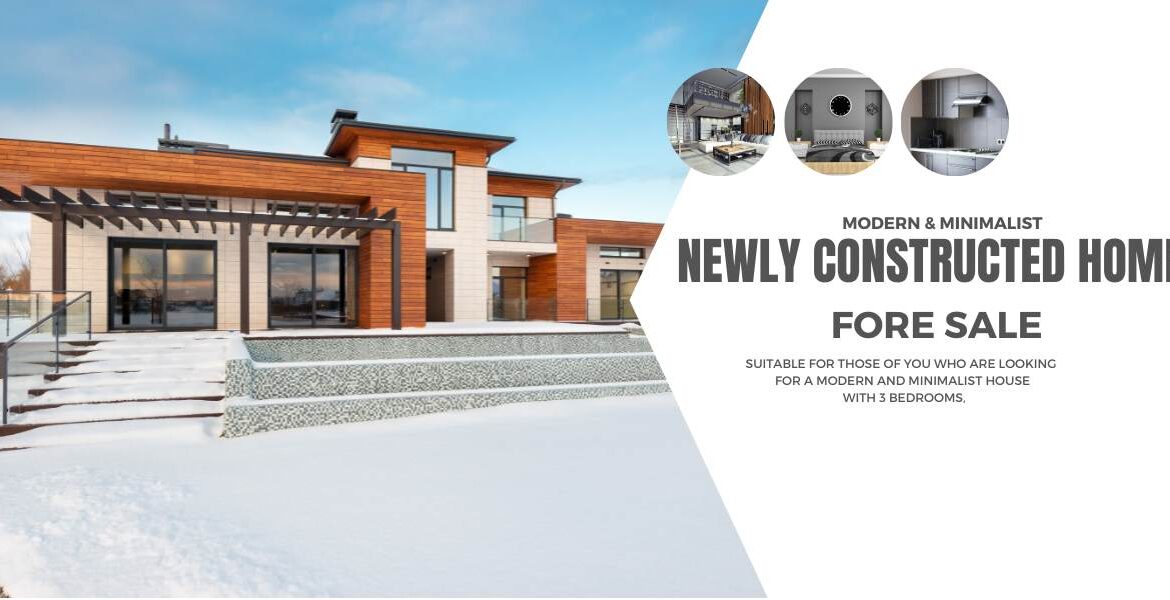Embarking on the journey of building a newly constructed home is a significant milestone in one’s life. It’s a dream realized, a canvas waiting to be painted, and a sanctuary where memories are born. In this 2000-word blog, we will delve deep into the intricacies of the home construction process, exploring every facet of turning an empty lot into a place you can call your own. From the initial planning stages to the final coat of paint, we’ll guide you through the art of crafting a newly constructed home.
The Blueprint Phase: Where Dreams Take Shape
The construction journey begins long before the first brick is laid or the foundation poured. It commences with a dream and an idea, which is then translated into a blueprint. This initial phase involves a symphony of professionals, including architects, designers, and engineers, all working together to turn your vision into a workable plan.
Architects are the visionaries of the construction world. They take your dreams and translate them into tangible designs. Their expertise lies in creating spaces that are not just functional but also aesthetically pleasing. Every detail, from the placement of windows for natural light to the choice of materials for a balance of beauty and durability, is meticulously planned.

Designers add personality to your home. They choose the colors, fabrics, and furnishings that will make your space uniquely yours. Their artistry brings the blueprint to life, ensuring that every corner of your home resonates with your personal style and taste.
Engineers, on the other hand, are the unsung heroes who ensure the structural integrity of your future home. They make sure the walls can bear the load, the plumbing works flawlessly, and the electrical systems are safe and efficient.
The permitting process, often underestimated, is a crucial step in the blueprint phase. Local regulations and building codes must be adhered to, which involves securing permits and approvals. It’s a labyrinthine process, but one that must be navigated to avoid complications during construction.
The Foundation: Laying the Groundwork for Your Dreams
With blueprints in hand and permits secured, it’s time to break ground. The foundation is where your dream begins to take shape, quite literally. There are various foundation types, each suited to different ground conditions and construction needs.
Slab-on-Grade Foundations: Common in areas with high water tables, slab-on-grade foundations are cost-effective and relatively simple. The home is built directly on a concrete slab poured on the ground.
Crawl Space Foundations: Ideal for regions with clay soil or where the water table is high, crawl space foundations elevate the house a few feet above the ground. This prevents moisture issues and makes maintenance easier.
Basement Foundations: Basements offer extra living or storage space, but they require excavation and waterproofing. They are perfect for expanding your home’s square footage.
Pier and Beam Foundations: These are often used in areas with unstable soil. Wooden or concrete piers support the house above the ground, allowing for ventilation and access to plumbing and electrical systems.
The foundation is the anchor of your home. It provides stability, support, and protection against the elements. It’s the first tangible step towards realizing your dream, and it’s essential that it’s done right.
The Framing: Building the Skeleton
With the foundation laid, it’s time to create the framework of your home. The framing phase is where the structure begins to take shape, resembling the skeleton of a living being. The primary materials used in framing are wood and steel, each with its advantages and applications.
Wood framing is the most traditional and widely used method. It’s cost-effective, readily available, and relatively easy to work with. However, it may be susceptible to termite damage and requires regular maintenance to ensure its longevity.
Steel framing, on the other hand, is gaining popularity due to its strength and durability. It’s resistant to pests, fire, and moisture, making it an excellent choice for areas prone to these hazards. Steel framing is also environmentally friendly, as it’s recyclable.
During the framing phase, walls are erected, and the roof structure takes form. It’s essential to ensure precise measurements and alignments to avoid structural issues down the road. Mistakes here can lead to crooked walls, sloping floors, and doors that don’t close properly.
The Inner Workings: Plumbing, Electrical, and HVAC
Once the framework is in place, the inner workings of your home come to life. During this phase of construction, plumbing, electrical, and HVAC (Heating, Ventilation, and Air Conditioning) systems are meticulously installed, ensuring that your new home is equipped for comfort, convenience, and safety.
Plumbing: This involves the installation of water supply lines, drainage systems, and fixtures such as sinks, toilets, and showers. The correct placement and secure connections are vital to prevent leaks and water damage in the future.
Electrical: The electrical system includes wiring for lighting, outlets, switches, and appliances. Electricians ensure that your home meets safety codes and that all your power needs are met.
HVAC: Your home’s comfort is greatly dependent on the HVAC system. Proper ductwork, insulation, and the installation of heating and cooling units ensure a cozy and climate-controlled environment year-round.
It’s crucial for all these systems to be installed correctly to ensure the safety, functionality, and energy efficiency of your home.
Insulation and Weatherproofing: Keeping Your Home Comfortable
A well-insulated and weatherproofed home is essential for energy efficiency and comfort. Insulation materials such as fiberglass, foam, or cellulose are installed in the walls and attic to regulate the temperature inside your home. Weatherproofing includes sealing gaps, adding weatherstripping to doors and windows, and installing moisture barriers.
Seeking to elevate your newly constructed home with seamless connectivity? At ‘buywirelessrouternow,’ we offer a wide range of wireless routers tailored to modern living demands. Just as your newly built home embodies the latest in comfort and convenience, our routers deliver the connectivity essential for smart homes and online family needs. Moreover, investing in effective insulation and waterproofing can lead to reduced energy costs, consistent indoor temperatures, and year-round coziness in your home, irrespective of the season.
The Exterior: Aesthetics and Protection
The exterior of your home is the first thing people see, and it plays a significant role in protecting your investment from the elements. This phase involves the installation of exterior siding, roofing, and windows.
Exterior Siding: Siding serves both aesthetic and protective purposes. It enhances the curb appeal of your home and shields it from weather damage. Common siding materials include vinyl, wood, fiber cement, and stucco.
Roofing: A solid and reliable roof is non-negotiable. Roofing materials can range from asphalt shingles to metal, tile, or slate. The choice depends on your climate, budget, and design preferences.
Windows: Windows bring in natural light and provide ventilation. High-quality windows not only enhance the beauty of your home but also improve energy efficiency. Double-paned, low-E windows are excellent choices for insulation and UV protection.
The interior design, including paint, finishes, and fixtures, transforms a structure into a home. This phase is where you make your mark, reflecting your personality and style in every room.
Paint: The color palette you choose sets the mood for each room. Lighter colors can make spaces appear larger and more inviting, while darker tones create coziness and drama.
Flooring: Flooring options range from hardwood, tile, laminate, and carpet. Each has its advantages in terms of appearance and maintenance, so choose the one that suits your lifestyle.
Cabinetry and Fixtures: The kitchen and bathroom are focal points of a home. Choose cabinets, sinks, faucets, and fixtures that not only look beautiful but are also functional.
Lighting: Lighting can make or break a room. A well-designed lighting scheme can create ambiance, highlight architectural features, and improve functionality.
The Landscaping: Creating an Outdoor Oasis
Your newly constructed home is not complete without a beautifully landscaped yard. The landscaping phase involves designing outdoor spaces, selecting plants, and creating hardscape features.
Outdoor Spaces: Patios, decks, and porches extend your living space into the outdoors. They’re perfect for entertaining, relaxing, and enjoying the fresh air.
Plants and Greenery: Choose plants that thrive in your climate and are low-maintenance. Landscaping should be both aesthetically pleasing and functional.
Hardscape Features: Walkways, retaining walls, and other hardscape elements provide structure and enhance the flow of your outdoor space.
The Final Touches: Quality Control and Inspections
Before you can call your newly constructed home complete, it must go through a series of quality control checks and inspections. These are essential to ensure that everything is in working order, meets safety standards, and is ready for occupancy.
Building Inspections: Local authorities conduct inspections at various stages of construction, from foundation to final inspection. They verify that the construction adheres to all relevant building codes and regulatory requirements.
Quality Control: Builders and contractors conduct their own quality control checks, addressing any issues or deficiencies. This is the last opportunity to fix any problems before you move in.
Home Warranty: Many new homes come with a warranty from the builder. This provides peace of mind, knowing that any defects or issues that arise after move-in will be addressed.
Conclusion: A Place to Call Home
The journey of constructing a new home is a multifaceted process that requires meticulous planning, skilled professionals, and attention to detail. It’s a creative endeavor, a scientific pursuit, and a testament to the dreams and aspirations of homeowners. Every phase, from the initial blueprint to the final touches, plays a vital role in crafting a space that is not just a structure but a place to call home.
As you embark on this exciting journey, remember that your newly constructed home is a reflection of your personality, your tastes, and your dreams. It’s a canvas waiting for you to paint it with your unique colors, textures, and memories. Embrace the process, savor every milestone, and relish the joy of turning an empty lot into a sanctuary that’s truly your own. Your new home is not just a structure; it’s a work of art, a labor of love, and a testament to your vision and dedication.







